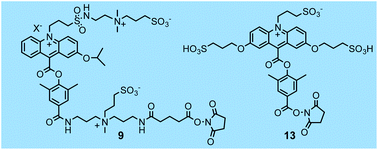Synthesis and properties of differently charged chemiluminescent acridinium ester labels†
Abstract
Chemiluminescent acridinium dimethylphenyl esters containing N-sulfopropyl groups in the acridinium ring are highly sensitive, hydrophilic

* Corresponding authors
a
Siemens Healthcare Diagnostics, Advanced Technology and Pre-Development, 333 Coney Street, East Walpole, MA 02032, USA
E-mail:
anand.natrajan@siemens.com
Fax: +1-508-660-4591
Tel: +1-508-660-4582
Chemiluminescent acridinium dimethylphenyl esters containing N-sulfopropyl groups in the acridinium ring are highly sensitive, hydrophilic

 Please wait while we load your content...
Something went wrong. Try again?
Please wait while we load your content...
Something went wrong. Try again?
A. Natrajan and D. Sharpe, Org. Biomol. Chem., 2013, 11, 1026 DOI: 10.1039/C2OB27190G
To request permission to reproduce material from this article, please go to the Copyright Clearance Center request page.
If you are an author contributing to an RSC publication, you do not need to request permission provided correct acknowledgement is given.
If you are the author of this article, you do not need to request permission to reproduce figures and diagrams provided correct acknowledgement is given. If you want to reproduce the whole article in a third-party publication (excluding your thesis/dissertation for which permission is not required) please go to the Copyright Clearance Center request page.
Read more about how to correctly acknowledge RSC content.
 Fetching data from CrossRef.
Fetching data from CrossRef.
This may take some time to load.
Loading related content
